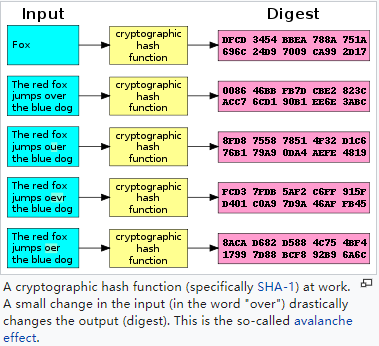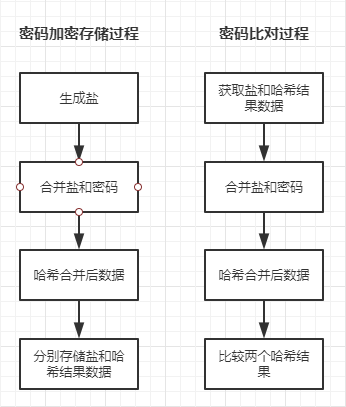一种密码加密存储方案:加盐哈希
今天来聊一聊一种被广泛使用的密码加密存储方案:加盐哈希。
本文包含以下内容:
- 什么是盐?
- 什么是哈希算法?
- 加密与校验过程。
- C#实现。
什么是盐?
In cryptography, a salt is random data that is used as an additional input to a one-way function that hashes data, a password or passphrase. -- From Wiki.
其实说白了,盐就是在密码学中用于加密的随机数据。
什么是哈希算法?
A cryptographic hash function (CHF) is a hash function that is suitable for use in cryptography. It is a mathematical algorithm that maps data of arbitrary size (often called the "message") to a bit string of a fixed size (the "hash value", "hash", or "message digest") and is a one-way function, that is, a function which is practically infeasible to invert. -- From Wiki.
密码哈希函数(CHF)是适用于密码学的哈希函数。 这是一种数学算法,可将任意大小的数据(通常称为“消息”)映射到固定大小的字符串上(“哈希值”,“哈希”或“消息摘要”),并且是单向的函数,不可逆转。这里包含了密码哈希函数重要的两个特点:1. 可将任意大小数据映射到固定大小数据上。2. 不可逆转。参考下面的图片(源于Wiki),不管input长短,经过哈希算法之后,都会生成一个固定长短的哈希值。并且在input上一个微小的改变,对哈希结果的影响都是巨大的。

加密与校验过程

C#实现
生成盐
1 /// <summary> 2 /// 生成盐 3 /// </summary> 4 /// <returns></returns> 5 public static byte[] GetSalt() 6 { 7 //Buffer storage. 8 var salt = new byte[8]; 9 using (var provider = new RNGCryptoServiceProvider()) 10 { 11 provider.GetBytes(salt); 12 } 13 return salt; 14 }
合并盐与明文
1 /// <summary> 2 /// 合并盐与明文 3 /// </summary> 4 /// <param name="byte1"></param> 5 /// <param name="byte2"></param> 6 /// <returns></returns> 7 private static byte[] CombineByteArray(byte[] byte1, byte[] byte2) 8 { 9 var ret = new byte[byte1.Length + byte2.Length]; 10 Array.Copy(byte1, 0, ret, 0, byte1.Length); 11 Array.Copy(byte2, 0, ret, byte1.Length, byte2.Length); 12 return ret; 13 }
哈希合并后数据
1 /// <summary> 2 /// Hash Salted input and salt 3 /// </summary> 4 /// <param name="input">input</param> 5 /// <param name="salt">salt</param> 6 /// <returns>return 32 bytes hashed values</returns> 7 public static byte[] HashSalted256(string input, byte[] salt) 8 { 9 var bytes = Encoding.Unicode.GetBytes(input); 10 byte[] hashSaltedValue = null; 11 using (var sha256 = new SHA256CryptoServiceProvider()) 12 { 13 var saltedInput = CombineByteArray(bytes, salt); 14 hashSaltedValue = sha256.ComputeHash(saltedInput); 15 } 16 return hashSaltedValue; 17 }
参考链接:
https://en.wikipedia.org/wiki/Salt_(cryptography)
https://en.wikipedia.org/wiki/Cryptographic_hash_function


